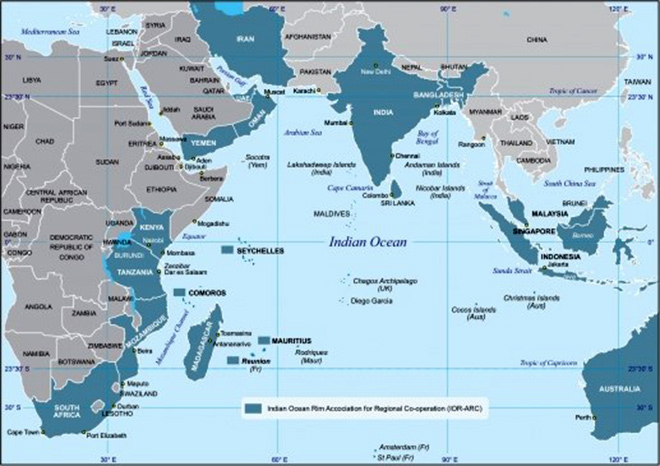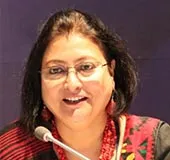
The ever-changing maritime strategy of India is a response to myriad geostrategic demands, to suit its ambition in the wider global order of substantial competition. Consequently, there is a perpetual renewal of maritime security propositions, aimed at widening the diplomatic pursuit for India. One such domain is the south – western Indian ocean, gaining salience in the recent past, where the major South Asian player- India- has been trying to ensure and stabilize its presence along with the other global powers like China, Japan, France and the United States of America, to mention a few, navigating through and harnessing the untapped potential of the African islands.
Map: Identifying the Western Indian Ocean
 Source: Denis Venter, ‘India and Africa: Maritime Security and India’s Strategic Interests in the Western Indian Ocean’, Fluid Networks and Hegemonic powers in the Western Indian Ocean.
Source: Denis Venter, ‘India and Africa: Maritime Security and India’s Strategic Interests in the Western Indian Ocean’, Fluid Networks and Hegemonic powers in the Western Indian Ocean.
The
delimitation of the south-western Indian ocean has been identified with important boundaries like the latitude 60°S- which is the northernmost limit of the Southern ocean, Cape Agulhas – the southernmost point of the African continent at longitude 20°E, the east coast of the African continent from South Africa in the south to Djibouti and Somalia in the north along with chokepoints of international importance like the Bab-el Mandeb, the Strait of Hormuz, finally running into longitude 88°E, comprehensively moving through Kolkata on India’s eastern coast, down to 60°S. This domain hosts several important island countries like Seychelles, Madagascar, Mauritius and Comoros, brewing Indian and global geopolitical interest for a very long time now. One of the primary reasons responsible for this affinity is the congenial location for the construction of advanced maritime naval bases, with more convenient spaces for air bases, since most of these islands are sparsely populated.
Historically speaking, Great Britain and France, as the colonial masters of this region, had been inherently utilizing such vital maritime locations for geo-economic, geo-political and geo-strategic benefits and it continued even after granting independence to these littorals. For instance, three islands such as Aldabra, Farquhar and Desroches were detached from the Seychelles group by the British administration for creating security bases. With the
recent participation of India in the Cyclone Diane affected Madagascar, as part of its HADR mechanism, with Indian Navy Ship INS Airavat, which was stationed in Seychelles (Port Vitoria), our focus has once again shifted to Seychelles and the maritime activities of India taking place there, with renewed emphasis on the stakes that India has, charting out narratives of any important power nexus that can be created for the country’s benefit.
In the contemporary times, the Indian Prime Minister Narendra Modi is all set to reclaim India’s stance here as a ‘
Leading Power’, reshaping its renewed outlook to a small country like Seychelles which holds within its self, one of the major capabilities to become a zone of feud as well as partnership, in global geopolitical terms.
Focusing India and Seychelles
The past three years have been specifically very eventful for the
India- Seychelles bilateral relationship (established in 1976) that has been garnering hopes for the further strengthening of Indian maritime diplomacy in the south-western Indian Ocean. In fact, Seychelles was one of the first countries to be visited by Prime Minister Modi, underlining the recognition that India had attached to this under-explored island nation. The national maritime blueprint of India,
Ensuring Secure Seas: Indian Maritime Security Strategy (2015)
, also specifically notes this island as a
‘primary area’ of interest that is in need of further engagement and collaborative efforts on part of both the governments. Although India has been moving forward with the establishment of the military base at the Assumptions Island in Seychelles, since 2018, the journey has not been very smooth. The other power players in the region have been quite sure that India wants to keep a keen eye on the Mozambique Channel through this settlement. It is also being closely observed by China that is omnipresent in the area, to be more specific- at Djibouti with its own naval capabilities, thereby causing apprehensions to India, whose main aim lies in controlling not only peace and stability in the region but also to make the best use of the chokepoints through which the maximum trade passes (specifically the major commercial vessels). It was as early as 2005 when India had realized that Chinese had lucrative offers for the country. As a result, they have been prompt enough to gift Seychelles with a patrol boat, to remain ahead. In this regard, it has been often argued that the Indian Navy is still caught up in a ‘
blind - spot’ in this area, as orientation and planning vis a vis a particular domain must not be motivated by the requirements of immediate actions, but must be calculated and framed well ahead in time. It must also be very wary of France and the cordiality that Seychelles shares with another French Island country, La Reunion. Though India has been
collaborating with France for the development of blue economy and fisheries and joint maritime surveillance, India must think beyond just countering China with potential partners, who themselves have been partnering with China (partnership with the
Francophone Indian ocean region), because of the trade necessities and protection against natural disasters. In short, India must not be caught up in any strategic dilemma of being surrounded by potential friends, but take the existing state of affairs with a pinch of salt.
Since 2018, not much development has been heard of, particularly with regard to the base, except for a few naval exercises in 2019 with ships of the First Training Squadron (1TS), INS Tarangini, INS Sujatha, INS Shardul and ICGS Sarathi and former Army Chief of India, General Dalbir Singh Suhag
appointed as the High Commissioner to Seychelles. This was a part of the
project ‘Sambandh’ that has been crafted by the Indian Navy at Port Vitoria, Seychelles. However, it must be kept in mind that developments in Seychelles should be brought about after certain consideration and speculation, given the sensitivity of the relationship. Even though cordial, the ties between the two countries have been tested through considerable hue and cry from the people of Seychelles, with demonstrations and protests, after which the agreement for the base was also amended. All that they are looking for is development of the country through cooperative measures and not get lost within any Asia centric power play. India very well realizes that focus and success on this region can be well made a part of the ‘Look West Policy’ of the country, which has focus on the West Asian countries. If India were well placed here, it would be able to control and keep check of the Strait of Hormuz, to be specific. Nonetheless, India is not maintaining this posture openly; neither has it declared its interest in this region as part of its looking west strategy.
In this circumstance, what India must focus on should primarily be guided by what the region needs at the moment. For example, India must pay heed to the requirements of further anti-piracy operations or Humanitarian and Disaster Management mechanisms which could be clubbed with the
Indian Navy’s Maritime Domain Awareness (MDA), which is mainly an Information Fusion Centre – Indian Ocean Region (IFC-IOR), launched in 2018. The vision of SAGAR of the Indian government should bring at the forefront to conduct constructive operations like the Maritime Information Sharing Workshop (MISW). In doing so, India must not forget to associate the vibrant
Indian Diaspora living (around 11 per cent of the total population in 2017) here, mostly from Tamil Nadu and Gujarat, excelling and dominating in trade and construction sectors. With their help, a more regulated output would be churned out by the government of India. Again, since the development of military structures are somewhat delayed for India, it must ensure the utilization of other sectors here like tourism and cultural exchanges and blue economy along with investments in maritime resources, which have been an integral part of the Indian Ocean Rim Association (IORA)
agenda, with increased information sharing mechanisms With ‘
shared development spaces’ and better participation of the media as well as the maritime university of Seychelles, a more prospective and viable environment can be created, focusing on the overall growth of both the countries and not only the containment of China or the nearby powers, who by virtue of the ethics of International strategy or diplomacy shall remain present, with all their best capacitates. Likewise, India can best come up with strategic zones of convergences through the identification of potential growth structures, for example, Seychelles-India- Maldives- Madagascar- as smaller zones- within the IORA for better development and cooperation. Likewise, given India’s potential in maritime capability, several such small frameworks can be created for immediate solution to problems like natural disaster, without having to wait, also capable of conducting naval exercises within themselves.
As India is trying to redefine its notion of the Indo-Pacific and the Indian Ocean per say, it has started to look for opportunities and areas beyond the ASEAN countries, through its Act East policy. It is now turning sailing through the unchartered waters of the African littorals, which is all set to be the next zone of contention, with India being a major stakeholder. Thus, as India considers this zone to be its
distant oceanic frontiers, the onus of protecting it and upholding its interest lies within itself. Though many questions like the future mechanisms in Indo-Seychelles relationship remain unanswered and undocumented for the general public of both the countries, treading small steps like helping the nearby islands in their hour of need seems to be a right step and the perfect tone for incorporating greater collaborative ventures in the future.
The views expressed above belong to the author(s). ORF research and analyses now available on Telegram! Click here to access our curated content — blogs, longforms and interviews.



 The ever-changing maritime strategy of India is a response to myriad geostrategic demands, to suit its ambition in the wider global order of substantial competition. Consequently, there is a perpetual renewal of maritime security propositions, aimed at widening the diplomatic pursuit for India. One such domain is the south – western Indian ocean, gaining salience in the recent past, where the major South Asian player- India- has been trying to ensure and stabilize its presence along with the other global powers like China, Japan, France and the United States of America, to mention a few, navigating through and harnessing the untapped potential of the African islands.
Map: Identifying the Western Indian Ocean
The ever-changing maritime strategy of India is a response to myriad geostrategic demands, to suit its ambition in the wider global order of substantial competition. Consequently, there is a perpetual renewal of maritime security propositions, aimed at widening the diplomatic pursuit for India. One such domain is the south – western Indian ocean, gaining salience in the recent past, where the major South Asian player- India- has been trying to ensure and stabilize its presence along with the other global powers like China, Japan, France and the United States of America, to mention a few, navigating through and harnessing the untapped potential of the African islands.
Map: Identifying the Western Indian Ocean
 Source: Denis Venter, ‘India and Africa: Maritime Security and India’s Strategic Interests in the Western Indian Ocean’,
Source: Denis Venter, ‘India and Africa: Maritime Security and India’s Strategic Interests in the Western Indian Ocean’,  PREV
PREV



